Augmented reality (AR) technology stands poised to transform the entertainment sector. By superimposing digital content onto the real world, AR unprecedentedly enriches live events, movies, and video games.
In live events, attendees can envision lyrics hovering in front of them during concerts or enjoy enhanced visual effects amplifying stage performances. Moreover, AR offers interactive opportunities like taking photos with virtual renditions of beloved artists. In film and television, AR promises immersive viewing, with theaters projecting effects onto walls or allowing viewers to select their camera angles.
AR elevates gaming experiences, offering real-time information overlay in first-person shooters or creating lifelike training scenarios for defense personnel with the help of augmented reality app development. With AR, entertainment enters a new era, blending digital and physical realms for captivating experiences.
What Is Augmented Reality Entertainment?

Augmented reality is a technology that enables users to view digital content overlaid with the physical environment. This can be achieved through various means, such as smartphone apps, dedicated AR devices, or head-mounted displays.
One of AR's distinctive features is its ability to facilitate natural and intuitive interaction with digital content. For instance, users can use their smartphones to point at physical objects, with the AR app development displaying additional information about those objects on-screen. AR holds vast potential with diverse applications across entertainment, education, and industry.
In entertainment, AR enriches live events, movies, and video games by integrating digital elements into the real world. In education, AR fosters interactive learning experiences and simulations. In the industry, AR aids technicians with maintenance instructions and provides virtual training solutions.
What Is Role of AR in Entertainment Industry?
The entertainment industry has eagerly embraced augmented reality technology, poised to transform how we engage with movies, live events, and video games.
AR's potential in entertainment is particularly thrilling in live events. By seamlessly integrating digital elements into concerts, plays, and performances, AR enhances the audience's experience. For instance, AR apps can display lyrics during a song's performance or add captivating visual effects to the stage. Attendees can also enjoy interactive experiences, such as taking virtual photos with their favorite performers.
In film and television, AR offers opportunities for more immersive viewing experiences. Theaters can use AR to project special effects onto walls and ceilings or even empower viewers to select their preferred camera angles during a film.
In the realm of video games, AR presents exciting possibilities. Imagine playing a first-person shooter game and seeing enemy positions and vital information displayed in your field of vision. Additionally, AR can be utilized to develop lifelike training simulations for military and first responders.
The AR in the entertainment industry is on the brink of a revolutionary shift, ushering in an era of unparalleled immersion and engagement for audiences worldwide.
Benefits of Augmented Reality in Entertainment
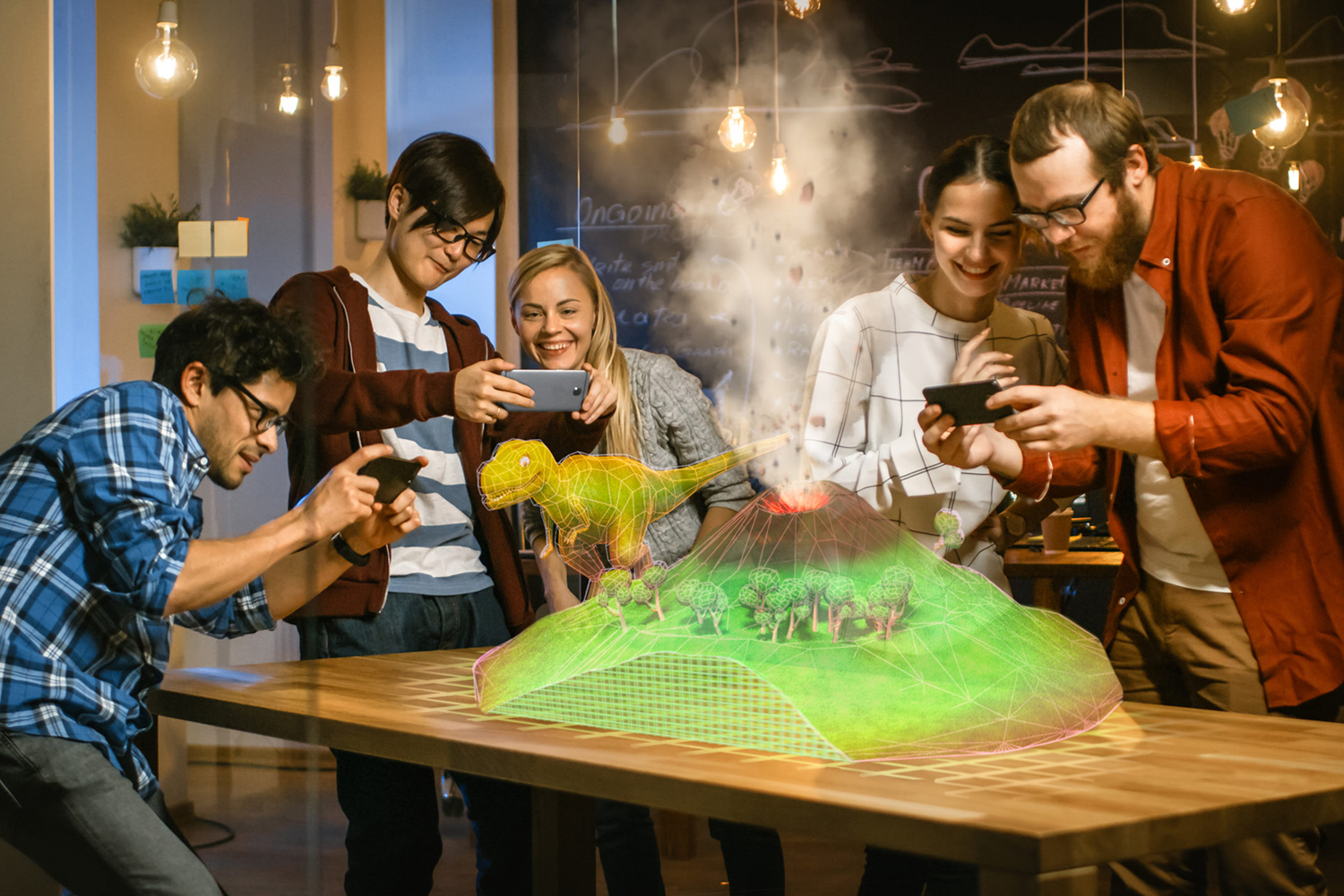
AR has proven its effectiveness in various PR and marketing endeavors in entertainment, spanning television, film, and other media promotional campaigns. Typically, these applications involve real-life object recognition or printed graphics, where the software identifies unique symbols via a webcam or cell phone camera.
The software then overlays graphics onto the webcam image, tracking fixed coordinates to create immersive experiences. Picture unlocking a virtual hat or a 3D mustache appearing over your head or extending your hand to see a minor 3D character interact with you onscreen. These examples demonstrate the mapping of experiences and objects onto real-time video imagery.

AR's historical exploration. AR technology allows users to explore historical locations through mobile devices, offering graphical overlays to educate about their significance. It aids tourist destination exploration and can be used for gaming and safety awareness initiatives.

Revival of print publications. With the help of AR you can injects new life into print publications like magazines and newspapers, making reading more appealing, especially to younger audiences. With its help, you can enable additional content and functionality, such as ticket purchasing and immersive AR advertising experiences.

Evolution of film and TV. You can enhance the viewing experience, making sports and movies more immersive and realistic with AR. Interactive TV powered by AR offers customized information to viewers, extending the scope of entertainment.

Augmented audio experience. AR technology extends beyond visuals, revolutionizing music and audio experiences. AR-powered earbuds enhance listening experiences by filtering background noise and customizing audio preferences.

Augmented travel experiences. Transforms travel experiences are transforme by providing enriched cultural information and new ways to explore destinations with the use of AR. It finds applications in museums and cities, offering interactive tourism, art, and communication solutions.

Disruption in the gaming industry. AR gaming experiences, such as Pokémon Go, digitize real-world situations for immersive gameplay. Theme parks integrate AR technologies, offering financially accessible virtual experiences alongside traditional attractions.
AR enhances sensory perceptions and provides access to a blend of reality and imagination, promising to revolutionize the entertainment industry.
Challenges and Limitations in AR Entertainment
AR entertainment also has its challenges and limitations, such as:

Limited range of offered pieces. AR entertainment retailers face challenges in offering a comprehensive range of products in AR environments. Creating virtual representations for every item in the inventory can be time-consuming and resource-intensive. Maintaining consistency between physical and virtual offerings poses logistical hurdles.

Lack of customer acceptance. Despite the potential benefits, there is a lack of widespread acceptance and adoption of AR technologies among entertainment consumers. Some consumers may perceive virtual try-on experiences as gimmicky or lacking authenticity compared to in-store shopping. Educating consumers about the benefits and functionalities of AR entertainment is crucial for overcoming resistance.

High barriers to entry. Implementing AR for entertainment solutions requires significant upfront investment in hardware, software, and expertise. Small and medium-sized retailers may face challenges in accessing and affording cutting-edge AR technologies. The complexity of integrating AR into existing infrastructure can pose technical challenges for retailers.

Expensive hardware solutions. AR experiences often rely on expensive hardware solutions such as headsets, sensors, and cameras. The high cost of entry for consumers limits the widespread adoption of AR technology in entertainment. Retailers must consider the accessibility and affordability of hardware solutions when implementing AR entertainment.

Security, safety, and privacy (SSP) threats. AR environments present potential security, safety, and privacy risks for consumers and retailers. Concerns about data breaches, unauthorized access to personal information, and cyberattacks may deter consumers from engaging with AR entertainment applications solutions. Retailers must prioritize SSP measures to safeguard customer data and ensure a secure and trustworthy shopping experience.

User perceptions and technological features. Users' perceptions of AR technologies influence their adoption and usage behaviors. AR is valued for its simplicity and user control, offering convenient and intuitive interactions. Balancing technological features with user preferences and comfort levels is essential for optimizing the usability of AR entertainment applications.
Looking to make a mark in VR entertainment? Trust Program-Ace for a professional touch!
How Is AR Used in Entertainment?
Augmented Reality rapidly extends its influence across various media platforms, from social media filters and lenses to interactive marketing campaigns and immersive experiences in concerts, games, films, and tours.
AR presents many creative opportunities for experiential agencies, product, and content directors to design distinctive and unforgettable experiences. Investing in AR technology and expertise is crucial for agencies to remain competitive and deliver innovative services. However, this investment can yield substantial returns by enhancing consumer-brand engagement. Furthermore, AR offers agencies valuable insights into user interactions and preferences, facilitating the creation of targeted content and marketing strategies.
Entertainment is a timeless industry that has existed since ancient times, evolving to impress and engage audiences with sophistication, as technology advances, entertainment adapts, continually inventing new ways to captivate us.
Game developers, filmmakers, musicians, and theater producers utilize cutting-edge technologies to create unforgettable experiences for millions. However, quality in development is paramount in ensuring a truly immersive and enjoyable experience.
Augmented reality development, particularly in entertainment, must be approached with professionalism. Only the best is accepted in entertainment, and any shortcomings are quickly noticed and criticized.
AR in Entertainment Examples to Get Inspired by
In the era of digital innovation, augmented reality has transformed the entertainment sector, providing immersive experiences that surpass our imaginations. From capturing virtual creatures in real-world settings to enhancing selfies with creative digital effects, AR has reshaped the entertainment landscape. Let’s look at the main AR in entertainment examples.
AR games
Snapchat filters
AR movie posters
AR concerts
Interactive storytelling
AR art exhibitions
Live AR filters for streaming

Pokémon GO, launched in 2016, revolutionized mobile gaming with its innovative use of augmented reality. Through AR, players use their smartphones' cameras to spot virtual Pokémon overlaid in the real world, creating an immersive gaming experience for users.
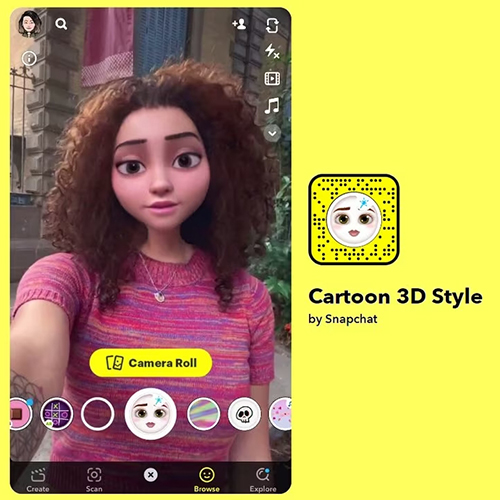
Snapchat Filters have become synonymous with AR's playful side on social media platforms. The evolving library of filters includes trends like "face swaps" and "gender swaps," often going viral and shaping pop culture’s digital landscape with their expressive features.
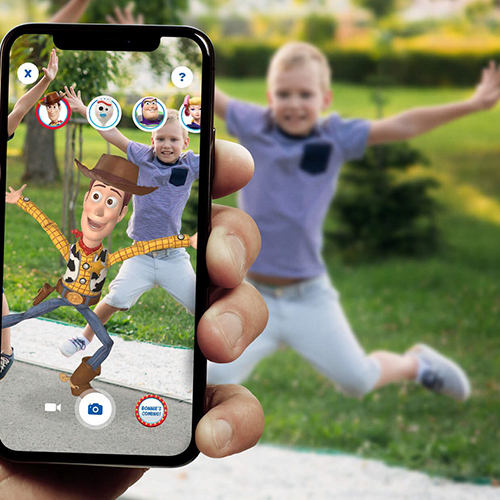
AR extends beyond gaming and social media to enhance the movie-viewing experience. AR movie posters allow users to view interactive content directly from static posters, such as movie trailers, making promotions dynamic, engaging, and significantly more immersive.
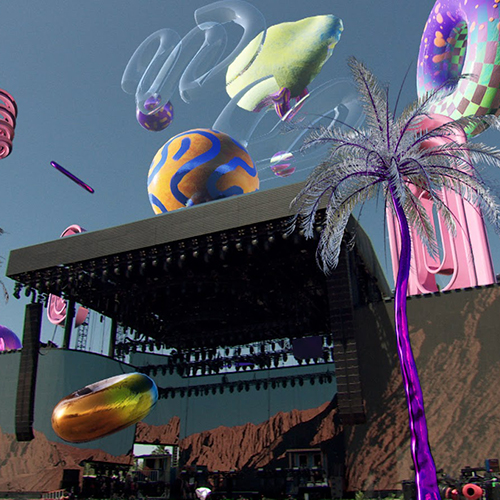
Augmented reality transforms live music experiences by seamlessly integrating digital elements into performances. Artists like Lady Gaga have fully embraced AR technology to offer interactive and immersive concerts, captivating audiences with virtual worlds alongside live music.

AR engages children in interactive storytelling, seamlessly blending narrative and technology. Apps like WonderScope and Holo enable kids to interact with characters, solve puzzles, and actively participate in stories, providing uniquely immersive experiences for young audiences.

Through AR, viewers can interact with artworks in ways previously unimaginable, adding a new layer to the art-viewing experience. An example is Japanese artist Yayoi Kusama who has used AR to extend her famous “Infinity Mirror Rooms” into virtual tours and spaces.
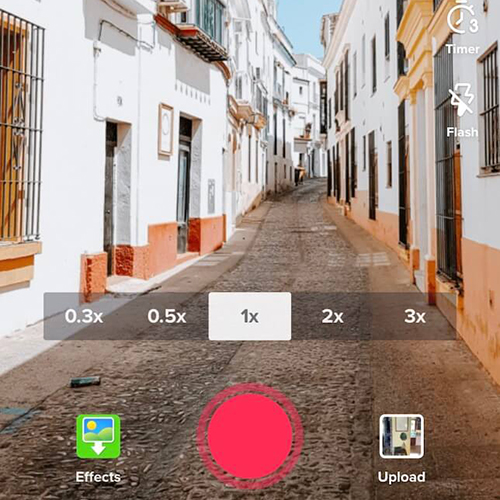
AR filters add a layer of fun to live streams, making them more engaging. Creators can don virtual masks, change backgrounds, or add effects to their live broadcasts. TikTok feature AR “green screen”, allowing creators to transport themselves to virtual environments.
Our exploration of AR in entertainment illustrates its transformative impact on enjoyment and recreation. From the worldwide sensation of Pokémon GO to Snapchat's whimsical filters, AR transcends mere technology. By blurring the boundaries of reality, AR amplifies interactivity, reshaping art, storytelling, live events, and marketing.
Program-Ace's AR Snapchat-like App for Japanese Food

AR Snpchat-like App is designed to take pictures or videos with all the variety of fancy effects related to Japanese culture such as samurai, sushi, fish, tempura, and share it with your friend on social media. Check this innovative solution that introduces Japanese food culture through entertainment.
Future of AR Entertainment — Trends and Possibilities
Augmented reality technology is poised to profoundly shape the future of entertainment. With mobile devices constantly by our side, the entertainment industry has unprecedented opportunities to reach and engage audiences on new levels.
Currently, AR enhances the impact of videos, multimedia, presentations, and games, expanding their reach to wider audiences. However, as AR deployment becomes more practical, it promises to revolutionize various entertainment fields, offering fresh and immersive experiences while enabling further exploration.
Let’s explore the latest AR trends and their impact on the entertainment sector.
Theater
Interactive theater experiences have emerged as a captivating form of entertainment, with surveys indicating that approximately 66% of people express interest in attending such performances over traditional shows.
The allure lies in the immersive and engaging nature of interactive theater, allowing audiences to actively participate and feel deeply involved in the unfolding narrative. Incorporating AI and VR technologies into theater productions can elevate the audience experience to new heights, offering dynamic and interactive storytelling that resonates deeply with modern audiences.
Museums and art galleries
While not necessarily a new trend, the adoption of AR (Augmented Reality) and VR applications in museums and art galleries continues to show promise. These technologies offer museums and galleries effortless ways to attract visitors and enhance their experiences.
Whether through interactive exhibitions or virtual tours, AI and VR technologies provide immersive and educational experiences that captivate audiences and encourage deeper engagement with art and culture.
Music performances and concerts
Despite being in the early stages of adoption, VR shows immense potential to revolutionize live music performances and concerts. Surveys indicate that music fans are willing to pay extra for VR-enhanced experiences due to their ability to create unforgettable and immersive musical atmospheres.
By leveraging VR technology, music performances can transcend traditional boundaries, offering audiences unparalleled access to immersive and interactive experiences that leave a lasting impression.
Amusement and theme parks
Amusement parks and theme parks are embracing VR technology to create unique and unforgettable experiences for visitors.
Whether through the introduction of VR rides or the integration of VR elements into existing attractions, AI and VR technologies enhance the overall park experience, enticing visitors with immersive and exhilarating adventures. By incorporating these technologies, parks can differentiate themselves in a competitive market and attract a broader audience base.
Sports
The sports industry stands to benefit greatly from the integration of AR and VR technologies, offering fans immersive and interactive experiences that enhance their enjoyment of live events.
VR broadcasts enable fans to experience live events in a 360-degree format, immersing them in the action as if they were on the sidelines. Additionally, AR technology provides real-time stadium details, player statistics, and other relevant information, enriching the overall fan experience and deepening their connection to the sport. By leveraging AI and VR technologies, the sports industry can engage fans in new and exciting ways, driving greater interest and participation in sporting events.
Marketing
AR in marketing is a powerful tool in advertising, offering virtual try-on experiences for fashion and beauty products, interactive product demos, and visualization of furniture or home design in natural environments.
In addition to fashion and beauty, AR is also revolutionizing the marketing efforts of other industries. For example, the automotive industry utilizes AR to provide immersive experiences for customers, allowing them to explore virtual showrooms, customize vehicles, and visualize different car configurations in real-world environments.
Innovative VR Entertainment Services by Program-Ace
Program-Ace stands out as a professional software development service provider, specializing in crafting innovative Entertainment app and game development solutions and AR app development. Backed by a robust portfolio showcasing our ability to deliver captivating virtual reality experiences, we serve a diverse clientele aiming to enhance their digital offerings. Our team blends technical prowess with creative vision, ensuring each project exceeds expectations in functionality and user engagement. Committed to staying at the forefront of VR technology, we continuously update our skills and tools to remain ahead of the curve.
Clients choose Program-Ace for our reliability, dedication to excellence, and proven track record in bringing concepts to life. For those eager to lead the way in VR entertainment, we welcome you to reach out to us. Together, we can explore the limitless potential of virtual reality.













